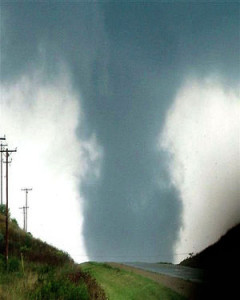
The tornado that struck Stoughton on August 18, 2005, is seen southwest of Highway 51 as it approached the city. Advances in radar technologies have helped to identify storms that are producing a tornadoes, or about to produce a tornado. Photo credit: Dale Bernstein NOAA/NWS
A tornado is a powerful, narrow column of winds that rotate around a center of low pressure. The winds inside a tornado spiral inward and upward, often exceeding speeds of 300 mph.
We cannot always tell if a developing storm will produce a tornado. Advances in radar technologies have helped to identify storms that are producing a tornadoes, or about to produce a tornado.
We do know the necessary conditions needed for tornado formation. And we are getting better at predicting those conditions a few days in advance, enabling forecasters to identify counties where there is a threat of severe weather sometimes as many as three days in advance.
For a thunderstorm to produce a tornado requires warm humid air near the surface with cold dry air above.
These conditions make the atmosphere very unstable, in the sense that once air near the ground is forced upward, it moves upward quickly and forms a storm.
Severe thunderstorm conditions also include a layer of hot dry air between the warm humid air near the ground and the cool dry air aloft.
This hot layer acts as a lid that allows the sun to further heat the warm humid air — making the atmosphere even more unstable.
To form a tornado, the host thunderstorm must also rotate. From below, a rotating bottom of the cloud looks like someone is stirring the storm from above. This happens in a storm when wind at the ground is moving in a different direction and speed than the air above.
The change in wind speed and direction with height is known as wind shear. Both wind shear and atmospheric instability are needed for tornado formation.

